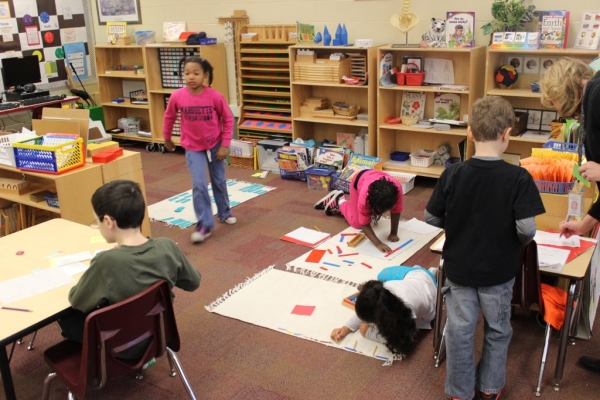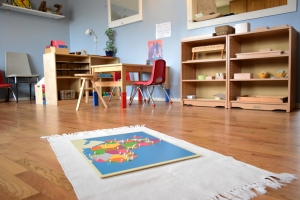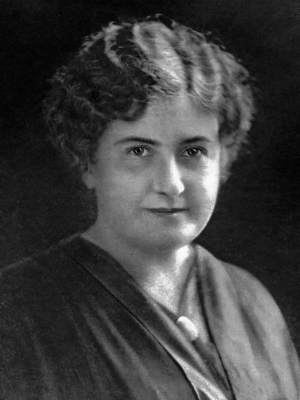
As a little girl born in a small town in Italy in 1870, Maria Montessori’s future appeared preordained. As a daughter of a government functionary, she might receive some education at a public elementary school, but her instruction would likely end at the age of twelve. Most girls of her age and social standing were married in their teens and raising a family by their twenties. Education, beyond the basics, was reserved exclusively for boys.
And yet before she died in 1952, Dr. Marie Montessori had received the French Legion of Honor, the Dutch Order of Orange Nassau, and an honorary doctorate from the University of Amsterdam. She’d also been nominated for a Nobel Peace Prize.
Maria’s unlikely journey from middle-class striver to a revered physician and educator began with an unusual advantage at home. Though her father held traditional views, often disagreeing with the trajectory of his daughter’s early life, Marie’s mother was forward-thinking and more educated than most women of her era. Her great-uncle was a Catholic priest who wrote treatises on geology and natural history. The aptitude for science clearly ran straight through the mother’s genes to young and brilliant Maria.
Maria Montessori’s Education
Maria’s education began in a public elementary school where she seemed to have middling talent. However, when she entered a secondary school at the age of thirteen, she took up the curriculum with enthusiasm, undeterred by the fact that she was the only girl in an all-boys school. She excelled in algebra, geometry, geography, and science to the point where she determined to continue her education after she graduated. She entered a technical institute intending to be an engineer, unheard of for a woman of the time, but when she finally graduated four years later with a degree in physics and mathematics, her interests had already turned to medicine.
Society in general didn’t approve. Her father, a retired army officer, didn’t approve. Both parents encouraged her to teach, instead. After all, no medical school in Italy had ever graduated a female doctor.
But twenty-year-old Marie Montessori persisted. She applied to medical school at the University of Rome and was refused. She studied harder to enter the university as a natural science student, passed her examinations to get her “license diploma” within a year. This achievement prompted the university to accept her into the medical program, some say with pressure from Pope Leo XIII who she appealed to for his endorsement and aid. Despite harassment from the male students, including those who refused to be in the same room with a woman while dissecting a naked body, she graduated in 1896, becoming the first female physician in Italy.
Only then did Dr. Montessori’s real work in developing one of the world’s most effective educational methods begin.
Dr. Montessori had focused on pediatric medicine at medical school, which led to an appointment after graduation to a clinic that treated mentally disabled children. During her stint in that ward, she began to question the contemporary methods of treatment and education. Unlike many of her colleagues of the era, Marie treated all patients equally, and exhibited great respect for the poor and disabled. She began to believe that the root cause of many of the undesirable behaviors that society called “delinquency” in these patients were due to a lack of support, understanding, and research for the troubles of mentally and developmentally disabled children. [She experimented with her own methods.] She also studied the work of some 19th century physicians known for their experience working with the famous “Wild boy of Aveyron.” Because of her interests, she was soon appointed a co-director of a new school, the Orthophrenic School, which served as an asylum for mentally challenged children. She experimented with her own methods.
Having some success with the mentally challenged, Dr. Montessori later decided she wanted to try her methods on “normally-abled” children to see if they would reap the same sort of benefits. By 1906, ten years after she’d received her doctor’s degree, the Italian government had enough faith in this maverick female doctor to put her in charge of a state-run school of sixty children in the breathtakingly poor San Lorenzo section of the city.
By this time of her life, Dr. Montessori was also a single mother, having borne a son, Mario, with her co-director at the Orthophrenic School of Rome. Because she would be expected to cease working if she married him, she declined to wed. Later in life, Mario would become an important part of her efforts to spread the news of the effectiveness of Montessori learning.
The San Lorenzo school became not only a successful school for the local children, who previously had been left to their own devices while their parents worked during the day, but also the center of Dr. Montessori’s continuing research and development into new educational methods. The San Lorenzo school became the first of many Casa dei Bambini, or Children’s House.
 While trained educators did the actual “teaching” under Dr. Marie Montessori’s guidance, Dr. Montessori sat back and observed the doings in the classroom. She noted when the students were absorbed and when they were unruly. She watched how they repeated certain activities, how they reacted to order and disorder in the classroom, and what motivated them to concentrate on certain tasks. The key to advancement and good behavior, she came to believe, depended on encouraging self-discipline, cleanliness, order, self-restraint, creativity, independence, and initiative. She noticed how swiftly children absorbed information, and how most of the learning they gained was through their own efforts.
While trained educators did the actual “teaching” under Dr. Marie Montessori’s guidance, Dr. Montessori sat back and observed the doings in the classroom. She noted when the students were absorbed and when they were unruly. She watched how they repeated certain activities, how they reacted to order and disorder in the classroom, and what motivated them to concentrate on certain tasks. The key to advancement and good behavior, she came to believe, depended on encouraging self-discipline, cleanliness, order, self-restraint, creativity, independence, and initiative. She noticed how swiftly children absorbed information, and how most of the learning they gained was through their own efforts.
The Montessori Method
Her observations led to the basic principles of the Montessori Method of education:
1. Children have absorbent minds, eager and ready to learn.
2. During childhood, children pass through sensitive periods when they are most amenable to heightened learning.
3. A prepared environment is crucial to encourage children to freely explore and actively learn.
4. When encouraged by new materials and active exploration, children want to engage in learning activities and teach themselves.
5. When shown respect and kindness, children will mirror the same positive social qualities.
Dr. Montessori also recognized and respected the unique individuality of the growing child, who will pass through sensitive periods of learning at their own pace. She began to believe that the ultimate goal of education was independence and initiative. The best role of a teacher in an academic classroom was to observe and guide to optimize each child’s innate psychological, social, and academic development.
Dr. Montessori’s first school was such a success that a second one was established within a year. The children in her programs, once considered “hopelessly delinquent” exhibited great concentration and self-discipline and learned to read and write beyond all expectations. The orderly classrooms drew the attention of journalists as well as prominent educators and scholars. Dr. Montessori’s schools exhibited many unique qualities compared to the schools of the era. The tables, chairs, and other furniture was lightweight and scaled small for children. Unique materials were used for classroom activities, such as letters cut out of sandpaper and picture cards. These materials were kept on low shelves so they’d be within the students’ easy reach. Children were involved in keeping the classroom clean and tidy, and every child engaged in practical-life responsibilities. The children were given freedom of movement and allowed to concentrate on lessons and play without interruption. Outdoor exercise, manual manipulation of materials, and conversation was encouraged.
Dr. Montessori published several papers that brought attention to her work internationally. Several more Italian schools were opened. By 1909, Switzerland began using the method in many of its kindergartens. The first Montessori school opened in Tarrytown, New York in 1911. In 1912, a Montessori school was established in Paris. Others were planned in Australia, Japan, Mexico, Syria, and many other countries. In December of 1913, Dr. Maria Montessori left Europe for the first time to take a steamship to America, where she’d been invited on a three-week lecture tour to discuss her Montessori Method of education. Not all educators believed or supported Dr. Montessori’s philosophy of education, and it was in America where some of her most vocal critics spoke their minds. One American educator of renown, William Heard Kilpatrick, went so far as to publish a critical book called The Montessori Method Examined which dismissed Dr. Montessori’s philosophy as too rigid and, oddly, outdated. Although the Montessori Method had already made inroads with many educators, the book by a prominent educator had a broad, and dampening, impact. Other American educators also took issue with Dr. Montessori’s insistence on wide control over the education of the teachers as well as the production and correct use of materials. After 1915, when Dr. Montessori left America, the push to spread the Montessori Method stumbled. It would take decades before educators re-examined the philosophy for use in America again.
Upon her return to Europe, Dr. Montessori settled in Barcelona. For the next thirty years she continued to develop her philosophy of teaching. In the 1920s, she expanded her research from early childhood education to consider the particular challenges of adolescence. Through her observational work, she concluded that this disruptive period of development was a reflection of the growing child’s need to understand their emergent selves, to find their niche in the world, and to grow into global citizens.
Planes of Development
From this research emerged another of Dr. Montessori’s important philosophies of developmental psychology. Through her work, Dr. Montessori labeled four distinct stages of human growth from infancy to adulthood, which she called “Planes of Development.” The stages (including some sub-stages) later became the basis of the three-year age groupings that are used in Montessori schools.
Stage One: The Absorbent Mind. From birth to age six, this plane of development recognizes that the cognitive leaps that lay down the basis of a child’s personality.
Stage Two: Conscious Imagination. From ages six to twelve, children develop abstract thinking, the ability to reason, and social relationships.
Stage Three: New Identity. The ages twelve to eighteen are a period of rapid growth, social development, and self-analysis about identity and their position in the greater world.
Stage Four: Maturity Cognitive growth and development continues from eighteen to twenty-four, when the emerging adult specializes in their work and learns to fit in with the greater society.
 In her later years, Dr. Montessori traveled all over Europe and India, starting new schools, teaching courses, opening teacher training institutes, and lecturing. In 1929, the first International Montessori Conference was held in Denmark, and it was here where she and her son Mario founded the Association Montessori Internationale, AMI, to oversee the training of teachers and the activities of Montessori schools worldwide. During this time she wrote two books, Education For A New World and To Educate The Human Potential. She also published a collection of lectures, What You Should Know About Your Child.
In her later years, Dr. Montessori traveled all over Europe and India, starting new schools, teaching courses, opening teacher training institutes, and lecturing. In 1929, the first International Montessori Conference was held in Denmark, and it was here where she and her son Mario founded the Association Montessori Internationale, AMI, to oversee the training of teachers and the activities of Montessori schools worldwide. During this time she wrote two books, Education For A New World and To Educate The Human Potential. She also published a collection of lectures, What You Should Know About Your Child.
From her first efforts with underprivileged children in Rome, Dr. Montessori was a fierce advocate for social justice. At the second International Montessori Conference, she spoke on peace and education, just as the fascist movement was rising in her home country. In 1934, after being put under political surveillance in Italy where she was overseeing Montessori institutions, she left her homeland and spent most of the war in India. With her son Mario at her side, she lived in Adyar, Chennai and began Montessori Method training courses for local teachers. A year later, when India joined the war effort, Maria and Mario were dubbed enemy aliens and interned, but still allowed to continue their educational efforts. She didn’t return to Europe until the conflict was over. After the war, she was nominated for the Nobel Peace Prize three years in a row.
In the century since the establishment of Dr. Montessori’s first school in San Lorenzo, Rome, the Montessori Method of education has spread over the world. Over 4,500 Montessori schools are currently established in the United States alone. It’s estimated there are around 20,000 such schools worldwide. All thanks to a brilliant 19th century Italian woman determined to follow the path of her intellectual curiosity to build a better world for all children.
Dr. Maria Montessori died in 1952, at the age of 81, but not before leaving behind an enduring legacy of an educational philosophy that continues to encourage academic excellence and an independent love of learning in children all over the world.





















